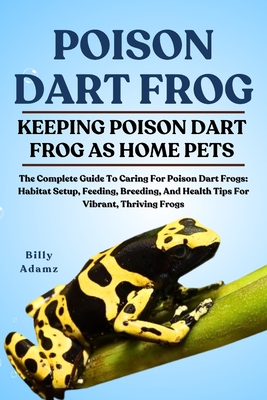Poison Dart Frog: The Complete Guide To Caring For Poison Dart Frogs: Habitat Setup, Feeding, Breeding, And Health Tips For Vibrant, Thriving Frogs

Poison Dart Frog: The Complete Guide To Caring For Poison Dart Frogs: Habitat Setup, Feeding, Breeding, And Health Tips For Vibrant, Thriving Frogs
Poison dart frogs, with their jewel-toned bodies and miniature size, captivate people around the world with a blend of beauty, mystique, and scientific intrigue. These small amphibians, hailing from the tropical rainforests of Central and South America, have inspired admiration and caution in equal measure. Their striking colors evolved as a warning to predators of the potent toxins found in their skin in the wild. Yet in captivity, these frogs are harmless, docile, and surprisingly adaptable, making them increasingly popular among amphibian enthusiasts.
This chapter explores the allure of poison dart frogs, dispels enduring myths, and presents the grounded truth about what it means to keep them in captivity. Whether you're just curious or considering one as a pet, understanding the biology, history, and misconceptions surrounding these frogs is the first step in responsible ownership.
The Allure of Poison Dart Frogs
For many, the initial attraction to poison dart frogs comes from their appearance. Few animals rival their vivid coloration: electric blues, neon oranges, deep reds, and striking greens that seem almost artificial. These colors are not only eye-catching but serve a biological purpose known as aposematism-a warning signal to potential predators about the frog's toxicity. In nature, these colors are a survival mechanism, but to humans, they are a visual marvel.
Aside from their aesthetics, dart frogs appeal to hobbyists due to their manageable size and the opportunity to create lush, living vivariums that mimic rainforest environments. Their small space requirements, coupled with their preference for humidity and dense foliage, make them perfect candidates for naturalistic or bioactive enclosures. Enthusiasts find joy not only in the frogs themselves but also in crafting miniature ecosystems filled with plants, mosses, and clean-up organisms like isopods and springtails.
Their behaviors also captivate keepers. Poison dart frogs are diurnal-active during the day-which sets them apart from many other frogs and amphibians that hide or remain inactive during daylight hours. They can often be seen hopping about, hunting tiny prey, or interacting with their environment. Males may call during the day, and some species demonstrate fascinating reproductive behaviors, including egg guarding and tadpole transport. These rich behaviors offer hours of observation and learning for t
PRP: 108.42 Lei
Acesta este Pretul Recomandat de Producator. Pretul de vanzare al produsului este afisat mai jos.
92.16Lei
92.16Lei
108.42 LeiLivrare in 2-4 saptamani
Descrierea produsului
Poison dart frogs, with their jewel-toned bodies and miniature size, captivate people around the world with a blend of beauty, mystique, and scientific intrigue. These small amphibians, hailing from the tropical rainforests of Central and South America, have inspired admiration and caution in equal measure. Their striking colors evolved as a warning to predators of the potent toxins found in their skin in the wild. Yet in captivity, these frogs are harmless, docile, and surprisingly adaptable, making them increasingly popular among amphibian enthusiasts.
This chapter explores the allure of poison dart frogs, dispels enduring myths, and presents the grounded truth about what it means to keep them in captivity. Whether you're just curious or considering one as a pet, understanding the biology, history, and misconceptions surrounding these frogs is the first step in responsible ownership.
The Allure of Poison Dart Frogs
For many, the initial attraction to poison dart frogs comes from their appearance. Few animals rival their vivid coloration: electric blues, neon oranges, deep reds, and striking greens that seem almost artificial. These colors are not only eye-catching but serve a biological purpose known as aposematism-a warning signal to potential predators about the frog's toxicity. In nature, these colors are a survival mechanism, but to humans, they are a visual marvel.
Aside from their aesthetics, dart frogs appeal to hobbyists due to their manageable size and the opportunity to create lush, living vivariums that mimic rainforest environments. Their small space requirements, coupled with their preference for humidity and dense foliage, make them perfect candidates for naturalistic or bioactive enclosures. Enthusiasts find joy not only in the frogs themselves but also in crafting miniature ecosystems filled with plants, mosses, and clean-up organisms like isopods and springtails.
Their behaviors also captivate keepers. Poison dart frogs are diurnal-active during the day-which sets them apart from many other frogs and amphibians that hide or remain inactive during daylight hours. They can often be seen hopping about, hunting tiny prey, or interacting with their environment. Males may call during the day, and some species demonstrate fascinating reproductive behaviors, including egg guarding and tadpole transport. These rich behaviors offer hours of observation and learning for t
Detaliile produsului









